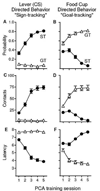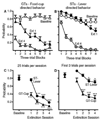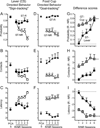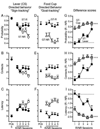Rats that sign-track are resistant to Pavlovian but not instrumental extinction
- PMID: 26235331
- PMCID: PMC4681397
- DOI: 10.1016/j.bbr.2015.07.055
Rats that sign-track are resistant to Pavlovian but not instrumental extinction
Abstract
Individuals vary in the extent to which they attribute incentive salience to a discrete cue (conditioned stimulus; CS) that predicts reward delivery (unconditioned stimulus; US), which results in some individuals approaching and interacting with the CS (sign-trackers; STs) more than others (goal-trackers; GTs). Here we asked how periods of non-reinforcement influence conditioned responding in STs vs. GTs, in both Pavlovian and instrumental tasks. After classifying rats as STs or GTs by pairing a retractable lever (the CS) with the delivery of a food pellet (US), we introduced periods of non-reinforcement, first by simply withholding the US (i.e., extinction training; experiment 1), then by signaling alternating periods of reward (R) and non-reward (NR) within the same session (experiments 2 and 3). We also examined how alternating R and NR periods influenced instrumental responding for food (experiment 4). STs and GTs did not differ in their ability to discriminate between R and NR periods in the instrumental task. However, in Pavlovian settings STs and GTs responded to periods of non-reward very differently. Relative to STs, GTs very rapidly modified their behavior in response to periods of non-reward, showing much faster extinction and better and faster discrimination between R and NR conditions. These results highlight differences between Pavlovian and instrumental extinction learning, and suggest that if a Pavlovian CS is strongly attributed with incentive salience, as in STs, it may continue to bias attention toward it, and to facilitate persistent and relatively inflexible responding, even when it is no longer followed by reward.
Keywords: Discriminative stimuli; Extinction; Goal tracking; Incentive motivation; Occasion setting; Pavlovian conditioning; Sign tracking.
Copyright © 2015 Elsevier B.V. All rights reserved.
Figures








References
-
- Anselme P. Incentive salience attribution under reward uncertainty: A Pavlovian model. Behav Processes. 2014;111C:6–18. - PubMed
Publication types
MeSH terms
Grants and funding
LinkOut - more resources
Full Text Sources
Other Literature Sources

